by Texas Homesteader ~
The Western Soapberry Tree (or Sapindus saponaria ssp. drummondii) is native in North America. I make my own all natural zero-waste shampoo with the berries I harvest. It’s all I’ve used for nearly 10 years now.
Discovering A Soapberry Tree
I have a super-smart friend from whom I always learn oh-so-much. Recently we were at a luncheon together & she mentioned that she uses soapberries for shampoo – no conditioner required.
She puts dried soapberries in water and lets them sit for about 6 weeks before she removes the berries. Then she adds a bit of baking soda and uses it to clean her hair.
Well color me intrigued!
Then I found a Soapberry Tree on our property shortly thereafter. So I decided to give it a try. I’ve been using soapberry shampoo ever since, y’all!
Soapberries Are Not Soap Nuts
When you search for soapberries online, you’ll see that many people use ‘soap nuts’ and ‘soapberry’ interchangeably. But make no mistake – they’re not the same!
Soap nuts are light to dark brown and are not translucent at all. They are typically grown in China and throughout most of India. They’re well known for being used as a natural laundry detergent.
However the Western Soapberry Tree (or Sapindus saponaria ssp. drummondii) is a native tree in Texas and much of the southern United States.
Although you can also use them as a natural laundry detergent, I’ve found as a laundry detergent they’re better suited for lightly soiled cloth such cloth napkins and such.
I’ve never used soap nuts as shampoo and I’ve read they do not work well in that capacity. They may very well be too harsh for such cleaning. So be sure you’re using the translucent yellow berries (you can even see the black seed inside)
NOTE: Soapberry trees and their small translucent berries look surprisingly similar to Chinaberry and their slightly larger yet opaque yellow berries. Make sure you have the tree properly identified by your local extension agent before using it for any cleaning purpose.
Identifying A Soapberry Tree
My extension agent identified a tree in one of my pastures as a Western Soapberry tree. According to Texas A&M Forestry Services:
The fleshy part of the fruit is rich in “saponins,” and was used by Native Americans as a soap substitute; the seeds were used to make necklace beads. The yellow fruits and the common name “wild china” often confuse this species with the non-native Chinaberry tree (Melia azederach).
Making A Quart Of Soapberry Soap
I took about 4 dried soapberries and put them in a quart jar filled with filtered water. For future batches I think I’ll be using Harvested Rainwater.
And I plan to infuse fresh mint and/or rosemary with my rainwater too.
Every now & then when I walked by that jar on my counter I’d swirl the soapberries in the water. My friend told me to let them sit that way, swirling them occasionally for about 6 weeks.
Making Soapberry Shampoo
When the liquid was infused and tan colored, I mixed up my shampoo in a repurposed plastic bottle with a squirt-top lid.
You know, because… glass in the shower makes me nervous!
For each cup of infusion I added a teaspoon of baking soda. I mixed up enough to fit in my repurposed bottle.
A quick shake and then I placed the bottle in the shower to give ‘er a try.
Using My Soapberry Shampoo
Now this ‘shampoo’ doesn’t foam up like the commercial stuff does. So when it was time to use it I first wet my hair down in the shower.
I used a small squirt on each side of my head and a small squirt along the back as I massaged the infusion into my scalp.
Then I let it sit in my hair while I showered. At the end I rinsed it all out.
How Did It Work For My Hair?
My hair is super fine, board straight and dry. So I typically wash my hair every 2-3 days to keep it from drying out more. Even though it’s all natural, this soapberry shampoo didn’t require me to wash more frequently. Yea!
The first thing I noticed was that my hair seemed to be a bit heavier, which worked well for me. You see, when my hair is shampooed with the commercial stuff it tends to make it too light and fly-away. I liked the difference in the feel, almost thicker.
But sometimes your hair can also feel heavier when it’s time to shampoo because of accumulated oils. So I was worried that the heavier feel meant maybe it looked dirty or greasy.
But that wasn’t the case, I didn’t notice my hair looking greasy at all. This is the 2nd day after shampooing.
I also noticed a much softer feel to my hair than with the commercial shampoo. Something I really enjoy.
So these days I use my soapberry shampoo exclusively. I harvest more soapberries around the first or middle of November each year. Then I sprad them out to dry them completely and store them in a sealed glass jar.
Heck, I even planted a soapberry tree closer to the house so in the future harvesting soapberries will be even easier!
Gail Offered These Soapberry Tips:
Once you get used to the very low foam, you’ll love soapberry shampoo. Natural saponin doesn’t behave like lab created soaps, the marketers have convinced people that huge amounts of bubble means clean.
It means drying out your scalp and stripping your hair of natural oil, so they add oils, and sell conditioners. It also means wasting water, since you have to use so much to rinse the gunk out of your hair.
And we won’t go into the damage it does to the environment…
Soapberries clean everything well.
SHAMPOO: 1/4 teaspoon of baking soda to a pint makes a great shampoo (NOTE: I use 1 teaspoon per cup of prepared soapberry infusion instead ~TxH~)
LAUNDRY: 1/4 cup of soapberry liquid with 1 tablespoon each of borax and washing soda takes care of laundry
CLEANER: 1 pint of soapberry plus 1 tablespoon white vinegar takes care of windows, dishes, floors, and countertops.
All you need to clean everything in your world is cheap and safe. White vinegar, borax, baking soda, washing soda, hydrogen peroxide and soapberries!
Thanks Gail for your soapberry hints! Now I harvest soapberries each year and use them as part of my zero-waste cleaning.
~TxH~
Links In This Post
Zero-Waste Health & Beauty
-
- Zero-Waste Shaving Using A Safety Razor
- Low-Waste Snap Toothbrushes
- Homemade Minty Mouthwash
- Quick & Easy Homemade Deodorant
- MYO Light & Sheer Face Powder
- 3-Ingredient Beeswax Lip Balm
- Homemade Vanilla-Scented Shampoo Bar Soap
- 3-Ingredient DRY SHAMPOO Mix
- Homemade Hairspray
- MYO Naturally-Scented Hair Conditioner
- Morning Motivation Mint Soap
- Homemade Soap: Lavender/Rosemary
- How A Bidet Can Be An Eco Win
Want To See Our Natural Cleaning Posts?
- Homemade Powdered Laundry Detergent
- Why Complicate Cleaning?
- Grandma-Approved Cleaning Techniques
- Laundry-Scent Booster
- Cleaning Blood On Clothing
- Many Magical Uses For Baking Soda
- Make A Natural Air Freshener For Pennies
- How To Clean A Narrow-Neck Jar
- MYO Citrus-Scented Cleaner
- All-Natural Lavender-Scented Hand Scrub
- MYO All-Natural Carpet Cleaner
- Saving Your Fingernails While Cleaning
- Repurposing Mesh Bags For Scrubbing
- How To Use ALL Of Your Spray Cleaner
See All Our Natural Cleaning Posts

C’mon by & sit a spell! Come hang out at our Facebook Page. It’s like sitting in a front porch rocker with a glass of cold iced tea – lots of good folks sharing! You can also follow along on Pinterest, Twitter or Instagram.
If you’d like to receive an email each time a new blog post goes live it’s EASY to
Subscribe to our blog!
References:

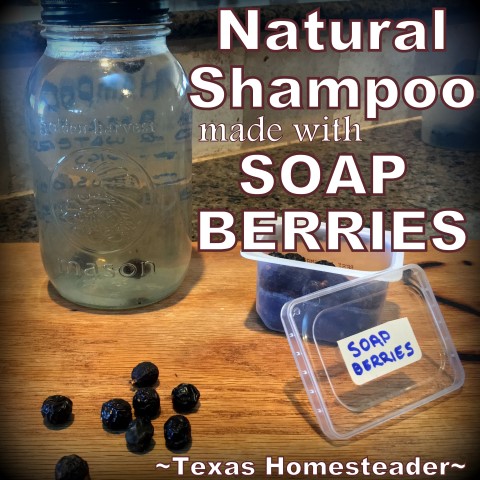
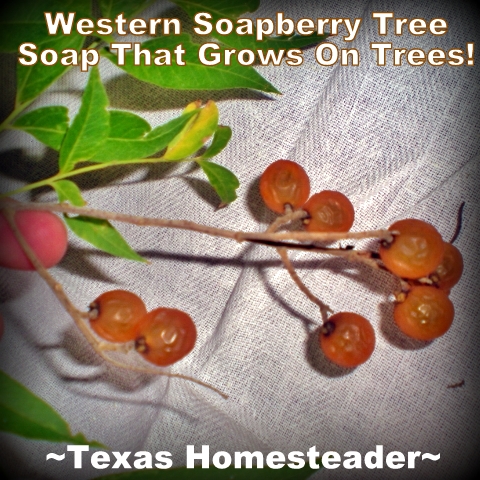
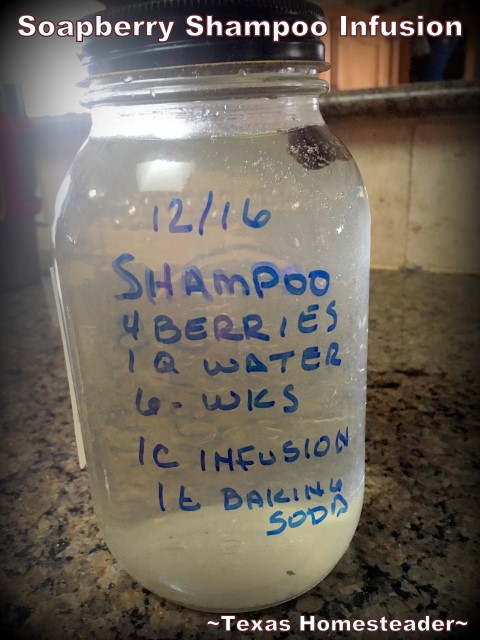
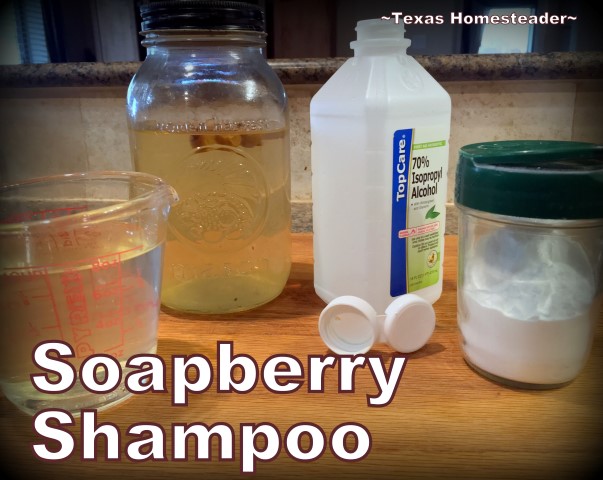
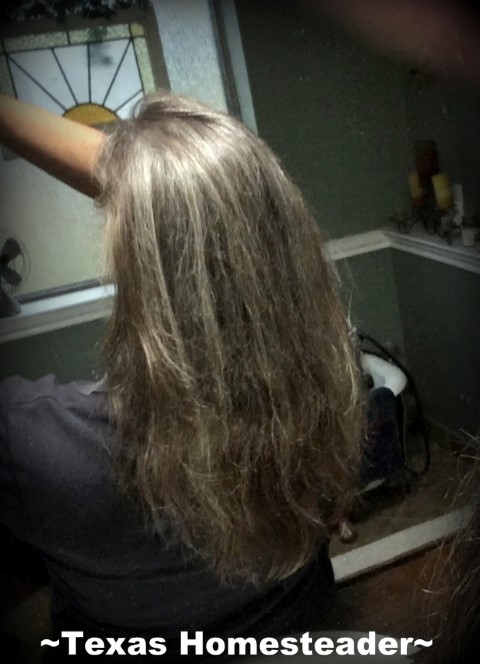
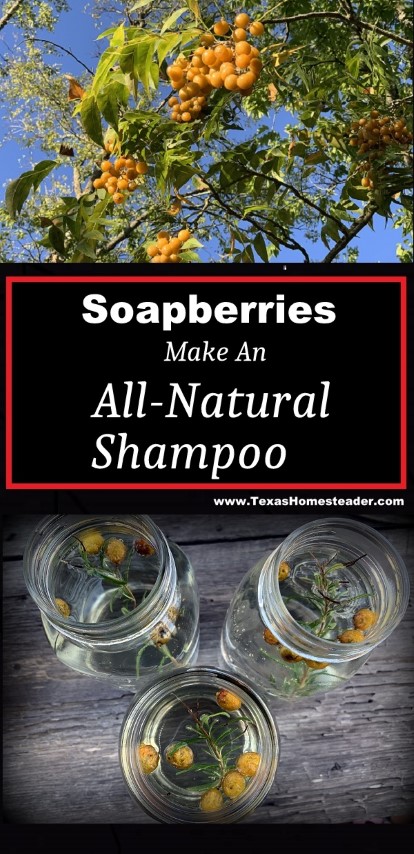



Hi,
I am intrigued with your soap berry shampoo.
I recently came across a soap berry tree in Northern Arizona.
Also came up on your website. Can you tell me how you infused fresh mint and/or rosemary?
The other question I have is how do I know the salt berries are dried enough to start this procedure?
thank you
Linda
First you want to make sure it’s actually a soapberry tree you’ve found. They look very similar to china berry trees. China berries are slightly larger, opaque and more yellow/white. Soapberries are somewhat smaller and a light amber color. They’re also semi translucent when they dry so you can see the single black seed through the skin of the berry. When in doubt, check with your extension agent who can probably properly identify for you. (that’s what I did) If it’s a soapberry tree you’ve found – Hooray! Soapberries stay on the tree long after the leaves have fallen off in the fall. That’s a great time to harvest them, and by that time they’re dry and shriveled. To infuse with mint or rosemary I’ll take some rainwater and bring it to a boil. Then I remove it from the heat and add either rosemary or crushed mint leaves and let the water steep much like you would for making tea. When it’s cool I strain out the solids and use that infused rainwater to make my soapberry solution. Although you have to get used to the lack of lather present in soapberry cleaning solution or shampoo, remember that lather doesn’t necessarily equate to cleaning. Soapberry shampoo produces precious little actual lather but it is all I’ve used for several years and I absolutely love it. Good luck! ~TxH~
Hi, thank you for the helpful information! We have a soapberry tree here in AZ. Just curious if you have ever dried yours to boil later?
If I’m making shampoo at harvest I’ll go ahead & use them fresh, Liz. But I’m typically starting with dried soapberries because they’re harvested and dried for use throughout the year. Making this shampoo works either way though, although I think it takes a bit longer to get your infusion the strength you want with the dried berries than it would with fresh ones. ~TxH~
I have a question,can the soapberry tree grow in Missouri?
Ya know, Teresa – I really have no idea. Your best source of region-specific information would be your extension agent. ~TxH~
Here’s a webpage that will answer your question. https://www.arborday.org/trees/treeGuide/TreeDetail.cfm?ItemID=1086
We live in NW OK and we have about 60 trees on our 650 acres. I may be lucky, but the berries grow mostly in the canopy of the tree and the side that gets the afternoon sun. I spent $400 on a tree pole extension, but man is that work. I need to find a buddy that owns a lift bucket, LOL.